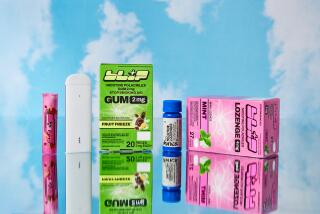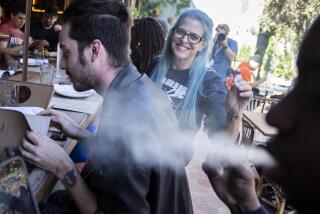No smoke, but lots of fuming
Customers at the Vapor Spot in Los Angeles puff on electronic vaporizers in an environment that looks like a cross between a swanky bar and a pharmacy, with black-shirted staffers tending frosted-glass countertops and hundreds of dropper bottles of “e-juice” lined up on the shelves.
The aroma inside is mildly sweet -- not what you might expect from a store full of people indulging in a nicotine habit.
Smokers have been banished from most public places, forced to nurse their addiction in private or outdoors.
But what about vapers, the name for people who draw on electronic cigarettes that spew no actual smoke? Instead, they inhale -- and then exhale -- e-juice as a vapor containing liquid nicotine, flavored with such tastes as fresh tobacco and cotton candy.
Should they be subject to the same restrictions?
Vapers argue that the emissions from a few ingredients must be cleaner than the thousands of charred chemicals flowing from the average cigarette. Critics worry that the devices and the components of their associated vapor are “untried, untested and unknown,” in the words of Stella Bialous, president of the San Francisco consulting firm Tobacco Policy International.
In the California Senate, lawmakers recently approved a bill that would ban vaping from every place smoking is already prohibited. The measure awaits discussion in the Assembly. UCLA has already taken that step, outlawing e-cigarettes on April 22, the same day it shut out their smoky cousins.
The laws would prevent vapers like 30-year-old Alexis, a Vapor Spot customer who did not want to share her last name because her family doesn’t know she ever smoked, from inhaling in her acting classes. For now, she can vape with no problem, though she used to have to walk outside to smoke. “I love it,” she says. “It doesn’t make me cough or smell.”
Vapor Spot bartender Chris Rogers says most customers come in to quit smoking. He started running after switching from smoking to vaping. “I feel healthier, I’m more energetic,” he says.
The problem is that little is known about the precise dangers of being in the same space as a vaper indulging their e-habit. Bialous says few studies have been done, and they were small and focused on a few brands. Personal vaporizers, and the “juice,” which is liquid laced with nicotine, in them, are so different from one another that the emissions of one may not match those of another.
In 2009, the FDA released results of a study on two kinds of e-cigarettes, reporting the presence of small levels of several toxins in the cartridges. For example, one sample contained 1% diethylene glycol, a component of antifreeze.
But thus far, no studies have shown that large amounts of dangerous chemicals are released into the air, says Dr. Michael Siegel, a professor at the Boston University School of Public Health.
“Unlike tobacco smoke, the vapor dissipates very quickly,” he says. “It looks like it’s probably very minor risk.”
However, there is a social risk, Bialous points out, in that vapers drawing on stick-like objects and puffing out a smoke-like substance looks a lot like smokers, and may serve to normalize the habit again. Might kids be attracted to a product enjoyed by the likes of Leonardo DiCaprio? “So far, there is no evidence that kids find this particularly cool,” Siegel says, though that “could change.”
Even when it’s technically allowed, some e-cigarette users avoid vaping in social situations. “I just don’t feel comfortable going into public places and vaping, because it looks like you’re smoking,” says Brian Worthy, owner of the Vapor-Mart in Los Angeles. He doesn’t want to upset bystanders, so he vapes only indoors at his home or store.
Many vapers aren’t particularly worried that their habit might be outlawed in public places.
“I don’t think it will affect me too much,” says Lee Madeloni, a musician who was trying flavors in the Vapor Spot, not far from UCLA, on a recent afternoon. “I’m pretty respectful anyway.” He already avoids vaping when dining with others, for example. And on an airplane, he sneaks a quick puff and blows the vapor down toward the floor -- fellow travelers may not even notice.
The bustling Vapor Spot attracts 18-year-olds to seniors, but mostly people in their 20s and 30s, Jenkins says. The blue-and-orange-walled store, which opened in 2009, was the first brick-and-mortar vape store in the country, he says. Customers can sit at one of six “bars” with a bartender to try the different flavors of juice.
Vapers note that their e-choice is still less harmful than cigarettes, and more pleasant in taste and smell, even if they must go outside to indulge. Nonetheless, there is still risk to the person puffing on an e-cigarette, if the juice contains nicotine. Even without the chemicals in traditional cigarettes, nicotine is bad for cardiovascular health and pregnant women, Siegel says.
But the plain nicotine in personal vaporizers must be less toxic than the complex chemical mix in cigarettes, reasons Jenkins, who sells U.S.-made juices he trusts.
“We’re making an informed, wiser decision,” Jenkins says. “We’re real picky about what we put in our bodies.”
However, he is careful to emphasize, right on his shop’s front door, that e-cigarettes are “use at your own risk” products.
--
--
(BEGIN TEXT OF INFOBOX)
How electronic cigarettes work
Electronic cigarettes deliver nicotine-laced, vaporized liquid instead of burning tobacco fumes.
Indeed, some users -- “vapers” -- prefer the term “personal vaporizer” to distance their devices from smoky, stinky cigarettes.
The basic personal vaporizer consists of a cartridge, atomizer and battery. The cartridge holds the nicotine-laced “juice” and a mouthpiece. The atomizer contains a small heating coil. With the push of a button, the battery powers the atomizer to heat the juice, turning it to a vapor.
Personal vaporizers come in a broad range of forms. Small versions look a lot like cigarettes. Many users prefer larger units, the size of a cigar or small digital camera, because the larger battery means they last longer without recharging.
A typical juice recipe contains four ingredients: propylene glycol, vegetable glycerin, liquid nicotine and natural or artificial flavor. Aside from the nicotine, these basic ingredients are accepted food additives. There are a variety of flavors, including tobacco and sweet tastes such as bubble gum or strawberry waffle. Juices contain different levels of nicotine, and some contain none. -- Amber Dance
More to Read
Sign up for Essential California
The most important California stories and recommendations in your inbox every morning.
You may occasionally receive promotional content from the Los Angeles Times.









